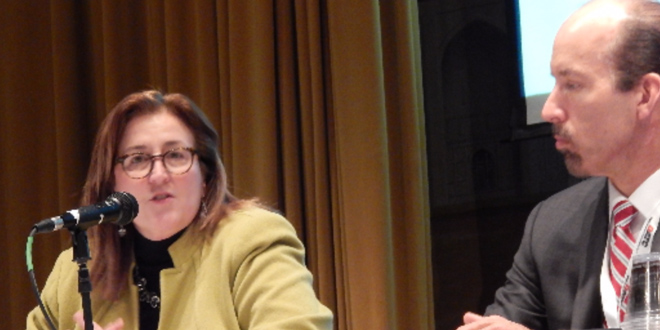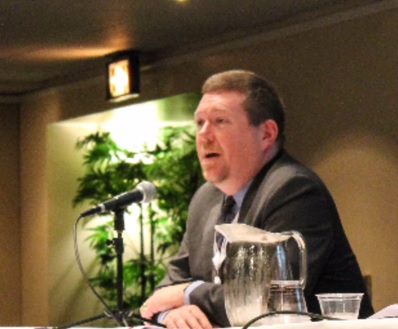By Rich Heidorn Jr. and Michael Brooks
WASHINGTON — The Federal Energy Regulatory Commission needs to do more to ensure Order 1000 opens transmission development to competition and results in interregional projects, developers said last week.
“FERC needs to go back to the drawing board,” Kristine Schmidt, vice president of regulated development for ITC Holdings, told Infocast’s 18th annual Transmission Summit, which drew more than 80 industry officials over three days. (Presentations from the conference are available here.)
Schmidt, a one-time aide to former FERC Commissioner Nora Mead Brownell, said Order 1000’s intent has been “watered down” since former Chairman Jon Wellinghoff left the commission in 2013, as a result of compromises to accommodate regional differences and “carve outs” on the original order’s prohibition against transmission owners’ rights of first refusal (ROFRs).
Schmidt said that while competition may eventually take hold as it did for independent power producers under FERC Orders 888 and 890, “we’re far away from that” now.
Randy Satterfield, executive vice president for Duke-American Transmission Co., agreed. “ROFR laws are in the way,” he said. “That has to be taken care of through FERC or the courts.”
Last May, FERC ruled that transmission planners may exclude consideration of non-incumbent proposals on projects subject to state ROFRs. FERC had previously required transmission providers to remove from commission-approved tariffs and agreements ROFRs giving incumbent utilities preferences to build transmission facilities selected in the regional transmission plan.
The commission ruled 3-1 that its previous position would require planners to evaluate non-incumbent proposals that had no chance of getting built because of state rules assigning them to incumbent utilities. (See Order 1000 Reversal: Reality Check or Surrender to Incumbents?)
‘Evolution’ in the RTOs

Satterfield said “the process is still evolving,” noting that while PJM has opened several “windows” for competitive proposals, SPP hasn’t identified any projects for competition and MISO has said it doesn’t expect to open any windows before 2016 at the earliest.
“So we’re being held back in that the opportunities in some of the RTOs are not yet there,” he said. He said that his company is “doing a fair amount of work in California,” which he said is “leading the pack.”
Although FERC has approved RTOs’ Order 1000 regional planning and cost allocation rules, “there’s still things that need to be buttoned up and tightened down” to ensure fair competitive processes, said Todd Fridley, vice president of Transource Energy. “We in the industry understand there will be growing pains as the market emerges.”
Schmidt said SPP made a wise decision in appointing an independent panel to judge competitive proposals and not leaving it to RTO planning staff, as in PJM. The panel’s recommendation would be submitted to SPP’s board of directors for review and approval.
“The RTOs were never formed to be the ones to choose winners and losers,” she said, adding, “RTOs have a long way to go to prove they have the discipline to evaluate proposals.”
Artificial Island
PJM’s April 2013 solicitation for a fix for stability problems at Artificial Island has proven a cautionary tale.
RTO planners recommended the selection of Public Service Electric and Gas last June. But objections by environmentalists and disappointed bidders led the PJM board to reopen the competition to four finalists. With the process still incomplete, PSE&G is now fighting PJM before FERC. (See related story, PJM: PSE&G’s Remedy for Artificial Island Bid Process ‘Draconian,’ ‘Self-Serving‘.)
“It’s not ideal. This is PJM’s first attempt at this,” said R. Mihai Cosman, a principal in Exelon’s corporate transmission development unit. “They’re trying to do the right thing. We in the future will have some sort of a standard process.”
Robert Daileder, a partner in law firm Nixon Peabody, said the unwieldy solicitation increased costs for competitors. “At the end of the day, the [winner] will probably be the best project … but the process may be much more expensive than anybody anticipated because of the changing goalposts,” he said.
“I think PJM has learned that maybe they didn’t scope it tightly enough,” said James Nicholas, who specializes in siting and licensing for CH2M Hill, an environmental and engineering consulting firm.
Interregional Projects

Developers also criticized the lack of interregional projects under Order 1000. The order requires transmission providers only to “consider” whether the needs identified in their local and regional transmission plans could be addressed most cost-effectively through joint projects with a neighboring region.
Satterfield said another obstacle to interregional projects is the disparities in competitive processes and cost allocation between regions.
“There can be great projects that cross seams and right now there is not a way to ensure those projects can proceed,” he said. “That’s got to get fixed.”
Schmidt said SPP’s northern expansion to Canada means its seam with MISO is growing. “It’s costing us a lot of money not having these projects on the table,” she said.
“Order 1000 did no favors to interregional planning. In fact, it’s not interregional planning, it’s interregional coordination,” said George Dawe, vice president of Duke-American Transmission Co.
“The RTOs, frankly, are doing what they’ve been required to do,” which is sharing information. He said the RTOs are conducting “quick-hit” studies that are not resulting in actionable projects.
Diana Rivera, director of market development and regulatory affairs for Clean Line Energy Partners, said interregional coordination is only occurring between neighboring regions, with much of the focus on seams issues. “Transmission needs that are broader in scope, like how do we move renewables to market, are not being addressed by interregional planning or cost allocation processes,” she said.
Brian Thumm, director of planning for ITC Holdings, compared Order 1000 to Aesop’s fable “The Monkeys and Their Mother,” in which the mother accidentally smothers one of her sons due to overly nurturing it.
The moral of the story is “The best intentions will not always ensure success.”
“I can think of no greater paradigm for what I’ve seen in the planning processes than to say that the best intentions of the industry have not guaranteed success in anything that we’ve done with respect to Order 1000,” Thumm said.



